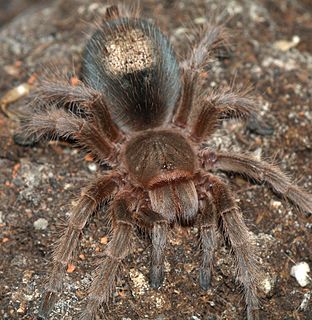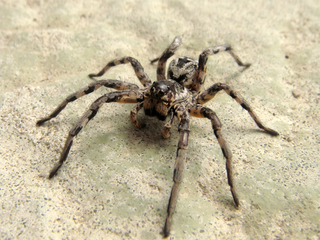
Urticating hairs or urticating bristles are one of the primary defense mechanisms used by numerous plants, almost all New World tarantulas, and various lepidopteran caterpillars. Urtica is Latin for "nettle", and bristles that urticate are characteristic of this type of plant, and many other plants in several families. This term also refers to certain types of barbed bristles that cover the dorsal and posterior surface of a tarantula's or caterpillar's abdomen. Many tarantula species eject bristles from their abdomens, directing them toward potential attackers. These bristles can embed themselves in the other animal's skin or eyes, causing physical irritation, usually to great discomfort. The term urticating hairs is a misnomer, as technically only mammals possess true hairs.

Brachypelma hamorii is a species of tarantula found in Mexico. It has been confused with B. smithi; both have been called Mexican redknee tarantulas. Many earlier sources referring to B. smithi either do not distinguish between the two species or relate to B. hamorii. B. hamorii is a terrestrial tarantula native to the western faces of the Sierra Madre Occidental and Sierra Madre del Sur mountain ranges in the Mexican states of Colima, Jalisco, and Michoacán. The species is a large spider, adult females having a total body length over 50 mm (2 in) and males having legs up to 75 mm (3 in) long. Mexican redknee tarantulas are a popular choice for enthusiasts. Like most tarantulas, it has a long lifespan.

Avicularia avicularia, sometimes called the pinktoe tarantula, is a species of tarantula native from Costa Rica to Brazil and the southern Caribbean. This species is sometimes called the Guyana pinktoe, common pinktoe, or South American pinktoe.

Lasiodora parahybana, the Brazilian salmon pink bird-eating tarantula, also simply known as the salmon pink or LP, is a tarantula from north-eastern Brazil and considered to be the third largest tarantula in the world.

Lycosa tarantula is the species originally known as the tarantula, a name that nowadays commonly refers to spiders in another family entirely, the Theraphosidae. It now may be better called the tarantula wolf spider, being in the wolf spider family, the Lycosidae. L. tarantula is a large species found in southern Europe, especially in the Apulia region of Italy and near the city of Taranto, from which it gets its name.

One of the larger species of tarantula, the Chaco golden knee, formerly known by Grammostola aureostriata, can be expected to reach between 20–22 cm (8.5 in).

Pamphobeteus is a genus of tarantulas that was first described by Reginald Innes Pocock in 1901. It includes some of the largest spiders in the world.

Poecilotheria metallica, also known as the Gooty sapphire ornamental, is an Old World species of tarantula. It is the only blue species of the genus Poecilotheria. Like others in its genus it exhibits an intricate fractal-like pattern on the abdomen. The species' natural habitat is deciduous forest in Andhra Pradesh, in central southern India. It has been classified as Critically endangered by the IUCN.
The genus Selenotypus includes one of the largest of Australia's theraphosids. At present, the only recognised species within this genus is Selenotypus plumipes, but this is expected to change, as it is becoming apparent that the genus has a wide distribution, and at present Australian theraphosids as a whole are poorly classified.

Hohenbergia stellata is a perennial species of the genus Hohenbergia. It is native to Trinidad and Tobago, Martinique, Netherlands Antilles, Venezuela, and northeastern Brazil.

Pamphobeteus nigricolor is a large species of tarantula found in Colombia and Brazil. First described in 1875 by Anton Ausserer as Lasiodora nigricolor, in 1901 Reginald Innes Pocock moved it to the new genus Pamphobeteus, and designated it as the genus's type species.

Tarantulas comprise a group of large and often ″hairy″ spiders of the family Theraphosidae. Currently, about 1,000 species have been identified. The term tarantula is usually used to describe members of the family Theraphosidae, although many other members of the same infraorder (Mygalomorphae) are commonly referred to as "tarantulas" or "false tarantulas". Some of the more common species have become popular in the exotic pet trade. Many New World species kept as pets have urticating hairs that can cause irritation to the skin, and in extreme cases, cause damage to the eyes.

The Mexican redleg or red-legged tarantula is a species of terrestrial tarantula closely related to the famous Mexican redknee tarantula. Like the redknee it is a docile tarantula and popular in the pet trade. It is slow growing and, like many tarantulas, females can live for decades.

The Texas brown tarantula, also known as Oklahoma brown tarantula or Missouri tarantula, is one of the most common species of tarantula living in the Southern United States today. Texas brown tarantulas can grow to leg spans in excess of 4 in (10 cm), and weigh more than 3 oz as adults. Their bodies are dark brown, though shades may vary between individual tarantulas. The colors are more distinct after a molt, as with many arthropods.

The Theraphosinae are a large subfamily of Mygalomorphae spiders in the family Theraphosidae found in the Neotropical realm.

Pterinopelma sazimai is a species of tarantula. It is known as the Brazilian blue or Sazima's tarantula. Iridescent blue in color, P. sazimai is native to an ecological island within the Chapada Diamantina National Park in Bahia, Brazil. In 2012, it became the first Brazilian species to appear on the International Institute for Species Exploration's Top 10 New Species list. The specific epithet sazimai honors Ivan Sazima, a Brazilian zoologist who was the first to collect exemplars of the species. This species is endangered due to the destruction of its habitat and overcollecting for the illegal pet trade.
L. cristata may refer to:

Typhochlaena paschoali is a species of tarantula, in the subfamily Aviculariinae. It is native to Brazil.

Lasiodora difficilis, common name Brazilian red birdeater, is a species of tarantulas belonging to the family Theraphosidae.

Lasiodora is a genus of tarantulas that was first described by Ludwig Carl Christian Koch in 1850. They are often very large; body lengths of up to 25 centimetres (9.8 in), including the legs, are not unusual.
















